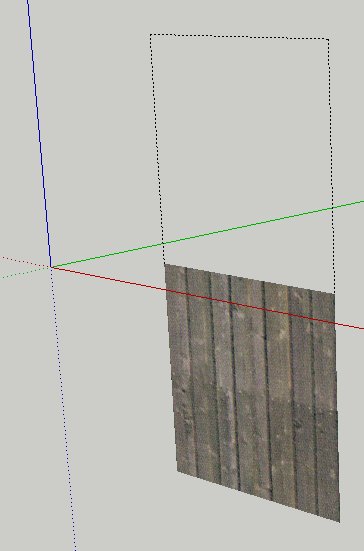[Code] Image: definition, transformation, transformation=
-
Thanks a lot Alex! This is very helpful.
The transformation method will return wrong result if an image is flipped (scaled in 'negative' direction).
If I will find a solution I will post it here.Will comparison of image's normal with and normal derived from edges do the trick?
-
What about looking at the edge loop .reversed_in? method or something? Will that help somehow?
-
@chris fullmer said:
What about looking at the edge loop .reversed_in? method or something? Will that help somehow?
I have tried it, but it doesn't work. Loop of the edges is in its 'untransformed' state stored in a image definition.
I am afraid that there is no way around it.
Btw. I didn't know, before I examined an image, that it is a 'special' ComponentDefinition (containing a face and four edges).
-
Is there a way to get all objects that has a vertex in a given point?
We could check whether there is the same image in a location of all face vertexes (after transformation), if not then the component would need to be flipped.
-
I believe you can detect a negative scaling by checking the determinant of the upper left 3x3 block matrix since all negative scalings have negative determinants unless they are simply a rotation. Here is some code.
def isflipped?(tr) m = tr.to_a() det = m[0]*m[5]*m[10] + m[1]*m[6]*m[8] + m[2]*m[4]*m[9] - m[2]*m[5]*m[8] - m[0]*m[6]*m[9] - m[1]*m[4]*m[10] if det < 0 then return true end return false endLet me know if that detects the transformations you're trying to modify. However I think there is a built in ambiguity here, if you're going to interpret negative scaling as a "flip" then what direction are you flipping? I think you could rotate the image around either of the two center lines and achieve a flip but then the question is which one would you expect when you do a -1 scaling transformation? Can you clarify how the current behavior differs from the expected behavior?
-
@cleverbeans said:
Let me know if that detects the transformations you're trying to modify.
The problem actually is to get the flipped transformation. The method always returns not flipped state.
It would be nice if theself.widthorself.heightwould return negative values. -
So the trouble is to get the transformation which will flip the image? Does this transformation give the behavior you're looking for? If so, do you want a transform constructed by Geom::Transformation.scaling(-1) method to produce the same behavior as this transform?
tr = Geom;;Transformation.new([-1,0,0,0,0,-1,0,0,0,0,-1,0,0,0,0,1]) -
The question is : Flip or not to flip and which axis? I am afraid we have no way to figure it out from Ruby alone.

The image in the SU is flipped vertically. The transformation returned from the method will have no negative scaling along Z axis, which results in an image placed in a position marked with hidden lines. -
You can get a transformation's scaling along each axis thus
[where 'tr' is the object's transformation object]def scaleX(tr) Math.sqrt(tr.to_a[0]**2+tr.to_a[1]**2+tr.to_a[2]**2) end def scaleY(tr) Math.sqrt(tr.to_a[4]**2+tr.to_a[5]**2+tr.to_a[6]**2) end def scaleZ(tr) Math.sqrt(tr.to_a[8]**2+tr.to_a[9]**2+tr.to_a[10]**2) endThis will NOT show the 'handing' BUT this should...
def flippedX?(tr) return true if tr.to_a[0] < 0 return false end def flippedY?(tr) return true if tr.to_a[5] < 0 return false end def flippedZ?(tr) return true if tr.to_a[10] < 0 return false endI think
 - try and see - there is a way even if I've messed this up!
- try and see - there is a way even if I've messed this up! -
I think the methods TIG described gives the right idea, however I'm not sure there is a problem with the code as provided. It seems as though you can transform the image in any meaningful way with a correctly articulated transform, and if it is not "working" as the user expects that be an issue with the user's understanding of how transforms work rather than with the code itself.
-
@unknownuser said:
@cleverbeans said:
Let me know if that detects the transformations you're trying to modify.
The problem actually is to get the flipped transformation. The method always returns not flipped state.
It would be nice if theself.widthorself.heightwould return negative values.Did you find a solution that worked?
-
As a 'Thanks!' to Alex and my contribution to wellness of other exporters and especially their developers
 here is my modified transformation method that works I think in 99.9%. It may fail due to float precision, but I looks it doesn't happen too often.
here is my modified transformation method that works I think in 99.9%. It may fail due to float precision, but I looks it doesn't happen too often.My idea is to calculate a center of the image, based on initially derived transformation and to compare it with a center of bounding box of the instance
self.bounds.center. If the points are not same it means that an image is flipped.If flipped, I create a modified transformation with a negative scaling along y axis.
Now I realized that this can be done by simply crating a
Geom::Transformation.scaling origin, 1, -1, 1and applying it to the original trans...def transformation origin = self.origin axes = self.normal.axes tr = Geom;;Transformation.axes(ORIGIN, axes.x, axes.y, axes.z) tr = tr * Geom;;Transformation.rotation(ORIGIN, Z_AXIS, self.zrotation) tr = tr * Geom;;Transformation.scaling(ORIGIN, self.width/self.pixelwidth, self.height/self.pixelheight,1) tr=tr.to_a tr[12]=origin.x tr[13]=origin.y tr[14]=origin.z trans = Geom;;Transformation.new(tr) #Global! trans of an image instance #check if flipped center_point=Geom;;Point3d.new(self.pixelwidth/2.0,self.pixelheight/2.0,0).transform! trans #center of an image center=self.bounds.center flipped=(center_point.x!=center.x or center_point.y!=center.y or center_point.z!=center.z) if flipped tr = Geom;;Transformation.axes(ORIGIN, axes.x, axes.y, axes.z) tr = tr * Geom;;Transformation.rotation(ORIGIN, Z_AXIS, self.zrotation) tr = tr * Geom;;Transformation.scaling(ORIGIN, self.width/self.pixelwidth, -self.height/self.pixelheight,1) tr=tr.to_a tr[12]=origin.x tr[13]=origin.y tr[14]=origin.z trans = Geom;;Transformation.new(tr) end return trans end#def
Advertisement







